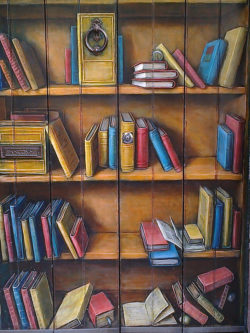Simon Burrows and Glenn Roe’s edited collection, Digitizing Enlightenment: Digital Humanities and the Transformation of Eighteenth-Century Studies, is a necessary reminder of the huge strides made by the field of eighteenth-century studies when employing the transformative tools of digital humanities. Impressive in its breath, this volume offers an in-depth view of several institutional projects, as well as sample DH applications to the study of the period. Ambitiously arguing that “the eighteenth century may … offer the perfect laboratory for applying digital technologies” (11), the editors have gathered contributions on major digitization efforts and DH projects undertaken in the past decade, many of them interrelated or involving transnational and cross-disciplinary collaborations, that have transformed in a relatively short period of time our understanding of the Enlightenment.
Sheila Liming. What a Library Means to a Woman: Edith Wharton and the Will to Collect Books.
The 2,700-plus books at the Mount, Edith Wharton’s historic Berkshire estate, represent only a portion of the novelist’s remarkable collection. Another 2,500 volumes, which one of Wharton’s heirs stored in a London warehouse after her death, were destroyed in the Blitz. And the volumes now in the Mount’s collection themselves survived storage in an English castle (some have the wormholes to show for it) and in a bookseller’s attic before a high-profile (and contentious) negotiation brought them to the Mount in 2006.
Access, Books, and Digital Collections
On the things I’ve learnt from a few years teaching students how to ‘read’ a digital instantiation of a book is that without some knowledge of the wider context of that digitization – the platform, database, collection, or archive – it can be difficult to understand why the way digitized books look the way they do. This worksheet enables students to begin to learn what’s involved in the digitization of books. In particular, it aims to help students explore the various legal, technological, and economic factors involved in the creation of large-scale digital collections; and also the cultural contexts of representation and access against the hype of universal knowledge. The in-class task, a paper prototype of a digital archive, works particularly well to bring home the difficult choices between sometimes contradictory factors involved in real-life digitizations. The session is part of a second-year undergraduate module entitled ‘Literature and Digital Culture’, following on from discussions in previous weeks about the digital medium, the digital divide and information privilege, and the representation of gender, race, sexuality, and intersectionality in Wikipedia articles.
The History of Paper: A Select Bibliography
In addition to our annual bibliographies, SHARP News will now also publish bibliographies focused on specific regions or on specific areas of study. We welcome any suggestions for future topics! This month we offer a select bibliography on paper and papermaking. Compiled by Cecile Jagodzinski in September 2021.
Roundtable Review: Queer/ing Book History. SHARP: Moving Texts. 2021.
Poring over card catalogues? Check. Feeling oddly compelled by titles, cover copy or illustrations? Check. Scrutinising author photographs and biographies, publishers’ colophons and blurbs? – I’m just going to come right out and say it. Queer readers are closet book historians. For much of the last century and the early years of the present one, a necessarily partial, subjective canon of queer literature could only be strung together by tenacious readers willing to follow such tenous, coded “threads of connection”, which depend as much on material books and their paratexts as on their content. “Before love”, as Valerie Rohy puts it, “there was the library; before intimacy, before identity, before community, there were books”. But although the links between sexuality and textuality are well-rehearsed, the scholarly fields of book history and bibliography have been somewhat slower to accommodate queer theories, methods and pedagogies.




